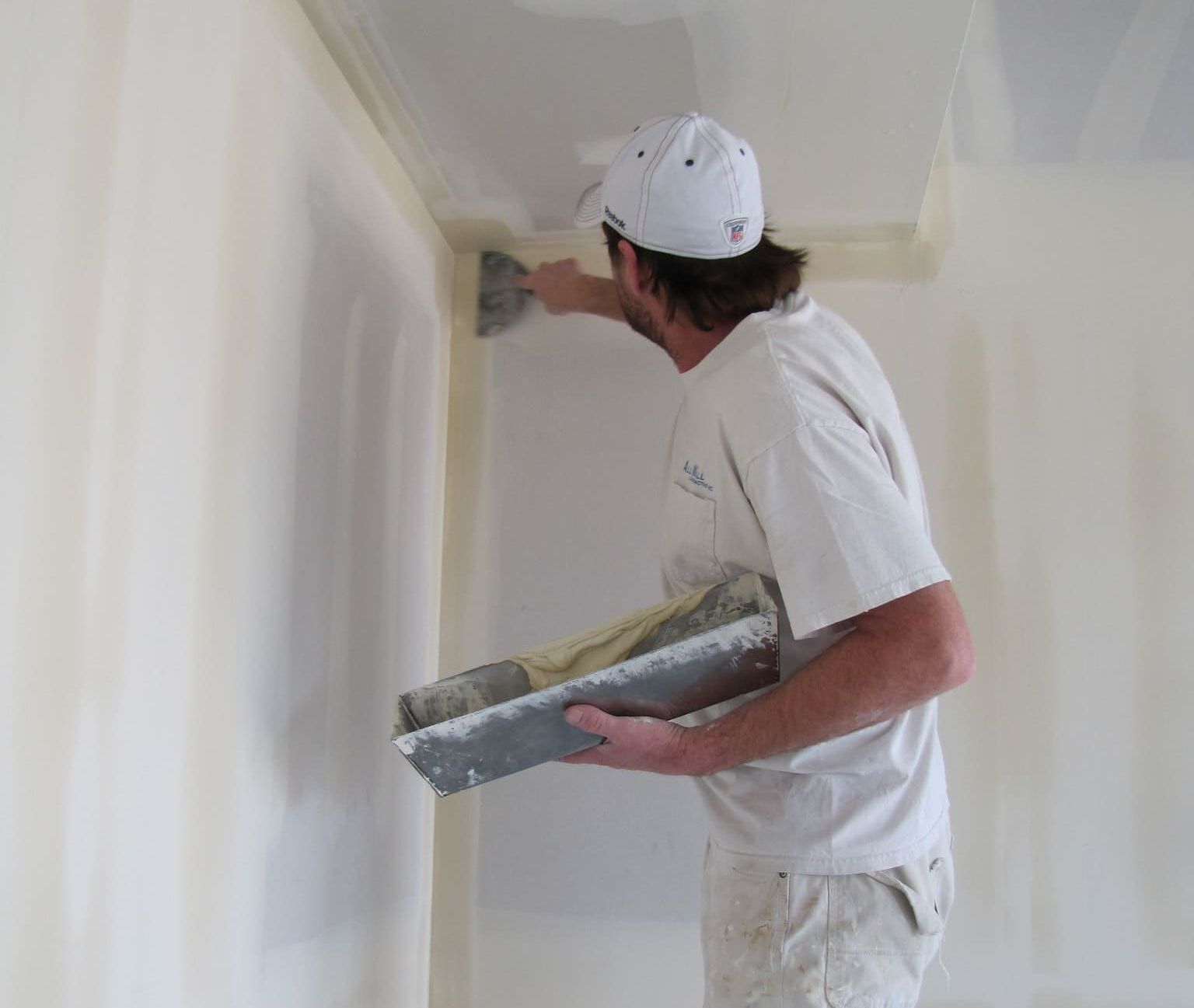Best Drywall Mud For Beginners
Drywall mud, or joint compound, is essential for achieving smooth walls during drywall installation. It's a paste applied over seams between drywall sheets, covering nails and repairing holes.
Choosing the
best drywall mud for beginners is necessary because it influences ease of application, drying time, and the overall finish. It's important to pick user-friendly products that suit your project needs, making the learning process more manageable and less frustrating.
Purpose of Drywall Mud
Drywall mud serves multiple functions in constructing and repairing walls and ceilings, particularly in ensuring durability and providing a refined finish. These are its key purposes:
Sealing Joints
It fills and seals the seams between individual drywall sheets, creating a smooth, continuous surface necessary for the stability of the structure.
Covering Screws and Nails
It conceals screws, nails, and other fasteners securing the drywall to the studs, ensuring they do not interfere with the wall's smooth appearance.
Repairing Cracks and Holes
It acts as a filler to repair any damages, cracks, or holes in the drywall, maintaining the integrity and uniformity of the surface.
Creating Texture on Walls
It can be manipulated to create various textures and patterns on walls, allowing for artistic and aesthetic expression in the room’s design.
Types of Drywall Mud
From Katie Burton's article titled "How To Use Drywall Mud And Which Kind You Should Buy," we get a clear list of some drywall mud types. Check these types she recommends and how to understand their characteristics and suitability and usage for your projects.
| Type of Drywall Mud | Description and Characteristics | Suitability and Usage |
|---|---|---|
| All-Purpose Compound | A versatile option that can be used for all phases of drywall finishing, including taping, topping, and texturing. It has good adhesion and is easy to sand. | Ideal for beginners due to its versatility and ease of sanding. Can be used for almost any drywall task. |
| Topping Compound | Lighter in weight, it is designed for the final coats over taped joints. It spreads easily and sands to a fine finish. | Preferable for use as a final coat due to its smooth finish and easy spreading. Not suitable for taping joints. |
| Taping Compound | Specifically formulated for embedding joint tape. It has high adhesion properties to hold the tape securely. | Appropriate for the initial taping phase, providing a secure hold for joint tape. |
| Lightweight All-Purpose Compound | Similar to all-purpose but lighter, it is easier to handle, spread, and sand, reducing user fatigue. | Especially beneficial for beginner usage due to its easy handling and reduced sanding effort. |

Considerations for Beginners
Ease of Sanding
For newcomers, a compound easy to sand is pivotal—it allows for a smooth finish and rectifications of any errors made during the application, easing the learning curve.
Shrinkage
Minimal shrinkage is significant to avoid the development of cracks and gaps after drying. The thickness of the application and the number of layers applied should be considered.
Ease of Application
Compounds that are easy to spread and adhere well are favourable for beginners, affecting the overall ease and success of the project.
Cost Consideration
| Type of Drywall Mud | Approximate Cost |
|---|---|
| All-Purpose Compound | Varies; generally cost-effective and widely available. |
| Topping Compound | Usually slightly more expensive due to specialized use. |
| Taping Compound | Typically moderately priced, based on brand and quantity. |
| Lightweight All-Purpose Compound | Price varies; lightweight features can increase the cost. |
Recommended Drywall Mud for Beginners
Choosing the right drywall mud can make a huge difference, especially if you're new to drywall installation. To help you find the perfect fit for your needs and preferences, below is a carefully curated list of recommended drywall compounds for beginners:
| Type of Drywall Mud | Ease of Use | Drying Time | Sanding Ease | Recommended For |
|---|---|---|---|---|
| All-Purpose Compound | High – versatile and suitable for most tasks. | Moderate – generally 24 hours per coat. | High – sands easily for smooth finishes. | Beginners for its versatility and ease. |
| Topping Compound | Moderate – best for final coats. | Fast – usually between 12 to 24 hours per coat. | High – results in a very smooth surface. | Final coatings due to its smooth finish. |
| Taping Compound | High – ideal for initial taping. | Moderate – approximately 24 hours per coat. | Moderate – can require more effort. | Initial taping phases for a secure hold. |
| Lightweight All-Purpose Compound | High – easy to handle and spread. | Fast to Moderate – around 12 to 24 hours per coat. | High – less effort required for sanding. | Various applications for its lightweight and easy handling. |
Practical Tips for Application
Following tried-and-tested steps when installing drywall not only ensures a flawless finish but also helps minimize the waste of materials. These are some valuable tips to ensure a successful drywall application:
Proper Mixing of Drywall Mud
- Before application, ensure the mud is mixed to a smooth, lump-free consistency, resembling a thick cream.
- Use clean water and mix gradually to avoid air bubbles, following the manufacturer's instructions for the finest results.
Application Techniques
- Use the Right Tools: Select appropriate trowels or knives for application, usually ranging between 6 to 12 inches.
- Apply Thin Layers: Start with thin coats, gradually building thickness, especially around joints and corners.
- Smooth Out: Ensure each layer is as smooth as possible to reduce the amount of sanding required later.
- Clean Tools Regularly: Keep your tools clean to avoid dried mud from mixing with fresh mud.
Layering and Proper Drying Time
Layering is pivotal in achieving a smooth, even finish with drywall mud. Allow each layer to dry thoroughly before applying the next to prevent cracks and ensure proper adhesion. Drying times can vary based on the type of mud used, environmental conditions, and the thickness of the application.
Sanding Tips for a Smooth Finish
| Sanding Tip | Action/Importance |
|---|---|
| Use Fine Grit Sandpaper | Fine grit ensures a smoother finish and reduces the risk of damaging the drywall. |
| Sanding Sponge for Corners | A sanding sponge is flexible and allows easier sanding in corners and other tight spots. |
| Dust Mask & Safety Goggles | Essential for protection against dust particles during sanding. |
| Circular Motion | Use circular motions with light pressure to avoid over-sanding and uneven surfaces. |
| Clean Surface between Layers | Remove dust between sanding layers to check for imperfections and ensure a smooth finish. |
Experiment With the Best Drywall Mud Options
Selecting the right drywall mud is important in achieving seamless and professional-looking walls and ceilings. For those new to drywall installation, experimentation and practice with different types of mud are essential to develop skill and familiarity with the material. Don’t be afraid to experiment with different compounds and techniques to find the best drywall mud for beginners that works best for you.
Frequently Asked Questions
-
Can I mix different types of drywall mud?
It's best to keep the same kinds of drywall mud, as each type is made for specific jobs. Mixing them can change how they work and cause drying and sanding problems. If you must mix them, try a small amount first to see if it causes any issues. Always follow the instructions on the label for quality results.

